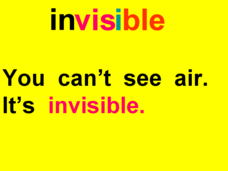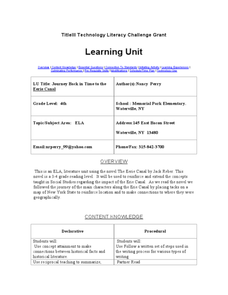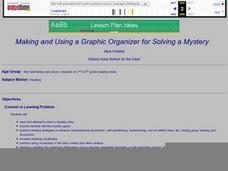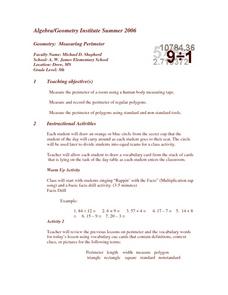Curated OER
Vocabualry words: Spelling pattern
Chunking words can help students with rhyming, fluency, and spelling. Here are six vocabulary words with definitions that are color chunked by syllables. There are two additional slides that have sentences. However, the purpose of these...
Curated OER
Musical Vocabulary Links
Students use well known songs to help them learn new vocabulary and apply meaning to the words. They make associations to the songs in order repeat and memorize new words. They use the Star Spangled Banner as an example in this lesson.
Curated OER
Vocabulary Practice-Grade One
In this grade one vocabulary worksheet, students use a word box to fill in blanks and correctly complete 5 sentences. Page has links to answers and additional activities.
Teaching Tolerance
Consuming and Creating Political Art
A picture is worth a thousand words, but political art may be worth even more! After examining examples of political cartoons, murals, and other forms of public art, class members create their own pieces to reflect their ideals and...
Curated OER
Jargon
Eighth graders investigate the concept of jargon and how it is used in different contexts in relation to the study of vocabulary. They practice interpreting jargon by concentrating on the comprehension strategy of using context clues.
Curated OER
Word Structure
Pupils infer the meanings of unfamiliar words using context clues and knowledge of prefixes and suffixes. They identify vocabulary words as nouns or adjectives using context clues and suffixes. In addition, they decide the meaning of a...
Curated OER
History Close to Home
Students examine primary sources as related to Nevada and the Civil War. In this United States history activity, students gather and analyze various primary sources in small groups and interpret unknown vocabulary words by using context...
Curated OER
Glossary
Show your class how they can use a glossary to determine the meaning of an unfamiliar word. A book about the great emperor penguin is used to hone in on vocabulary development through the use of context clues and the glossary found at...
Curated OER
Because of Winn-Dixie
Readers analyze an excerpt from Kate DiCamillo's novel Because of Winn-Dixie. They read silently, and then hear it read aloud. Definitions for underlined vocabulary words are in the margin, and other potentially difficult words...
Curated OER
Where is Shirley the Elephant?
Young animal lovers engage in a instructional activity that's all about elephants. They access an elephant sanctuary website and read a story about Shirley the elephant. They perform a series of activities based upon that story, and also...
Curated OER
Louisiana's Tragic Hero - "Evangeline"
"Ye who believe...List to a Tale of Love in Acadie." Longfellow's epic poem, "Evangeline," launches a study of tragic heroines, epic poetry, the expulsion of the Acadians from Canada, and their subsequent migration to Louisiana. The...
Curated OER
Kumeyaay Indians
Useful for literary analysis, citing textual evidence, or summary skills, this lesson about the Kumeyaay Indians would be a good addition to your language arts class. Middle schoolers read novels and summarize the literature in their own...
K12 Reader
Point of View: Who Is Telling the Story?
See how famous books of literature have different perspectives with a short activity. After reviewing the difference between first and third person points of view, learners look over six passages from various novels and decide which...
Curated OER
The Stolen Smell
Third graders read the story The Stolen Smell, and complete language arts activities based on the book. In this The Stolen Smell lesson plan, 3rd graders complete activities such as discussion, reading, researching, drawing, role...
Curated OER
Close and Shut
Open and closed - or open and shut? Using context clues in ten multiple choice questions, students choose whether they should use "closed" or "shut" to fill in the blank. This activity could be great addition to a vocabulary lesson in a...
Curated OER
Robin Hood: England's Man of Mystery
Students study the tale of Robin Hood to further their knowledge of character traits, improve their vocabularies, and increase their knowledge of the Medieval Ages. In this Robin Hood lesson, students complete 14 lessons that help them...
Curated OER
Unwind: Directed Reading Thinking Activity
To generate interest in reading Neal Shusterman's young adult science fiction novel Unwind, class members engage in a Directed Reading-Thinking Activity (DRTA) that asks them to examine the front and back covers, the blurbs, and "The...
Curated OER
Pendemonium: The Italian Job
Discover how to use prefixes and suffixes to determine the meaning of unfamiliar words. The group views a jovial video on the topic, and then they create a chart of prefix and suffix meanings to identify the meanings of words in a social...
Curated OER
Erie Canal: Journey Back in Time
Fourth graders read the novel, The Eric Canal, identifying the characters and setting. They respond to daily reading by writing in journals and complete a short answer test upon completion of the novel.
Curated OER
Making and Using a Graphic Organizer for Solving a Mystery
Students create tables in a word processing program which helps them organize their text clues when reading a mystery story. They develop reading comprehension strategies while using a computer based graphic organizer in order to solve...
Curated OER
Word Roots 2: Fin, Sed, Fer Intermediate Puzzle 1, 2, & 3
If you are interested in practicing Latin word roots in your class, consider this resource. Focusing particularly on the roots fin, sed, and fer, these brief fill-in-the-blank activities provide a word bank for reference. Learners look...
Curated OER
Spanish: Body Parts and Beyond
Young scholars drill on Spanish vocabulary words by participating in a card game. They use a list of teacher-prepared clues that are glued to cards. Later they apply these words to skits and dialogues about health issues.
Curated OER
Measuring Perimeter
Have your class practice measuring the perimeter of various objects using this resource. Fifth graders place various-sized polygons in order (from largest to smallest). They use non-standard measuring tools to estimate the distance...

























